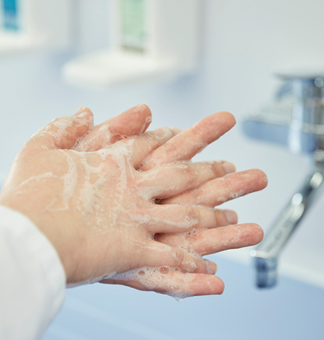Disinfectant or soap? Meta-analysis examines efficacy against community-transmitted respiratory infections

To reduce the risk of surgical site infections (SSI), sterile surgical gloves are worn during surgical interventions. As surgical gloves become perforated in 30-40% of all surgeries, also the transient flora of the hands must be reduced [1, 2]. To this end surgeons perform surgical hand disinfection before every surgical intervention. While surgical scrubbing (surgical handwashing with chlorhexidine- or iodine-based antimicrobial soap and water by means of a brush) used to be the hygienic standard of surgical hand disinfection for many decades, alcohol-based handrubs (ABHR) are gaining more popularity recently [2]. When ABHR are used for surgical hand disinfection, handwashing takes place only once a day before entering the operating room or when the hands are visibly dirty. However, despite greater effectiveness, less skin irritation potential and further time and cost advantages of ABHR, scrubbing is still frequently used in the surgical field. This article provides arguments for rethinking the process of surgical hand disinfection.
Independent of the method used for surgical hand disinfection, hygienic requirements have to be met. A recent systematic review that included bacteriologic studies showed comparable or superior reductions of bacterial colony forming units on the hand with ABHR vs scrubs. In addition, there was no difference in SSI, thus allowing to conclude that ABHR is a sound alternative for surgical hand disinfection [3]. In a comparison of a scrub product based on chlorhexidine gluconate (CHG) and a rub product based on 80% ethanol with a 60% n-propanol reference, the CHG product was found to be less effective than the reference product (significant difference) both immediately and after 3 hours, while the ethanol-based product was equally effective at both times (no significant difference) [4].

Similarly, in a recent study comparing hand scrubs and rubs, only handrubbing with 60% propanol maintained a sufficient reduction of the bacterial load after 3 hours, while an immediate reduction was seen for both products [5]. As surgical interventions can take longer than take 3 hours, sustained efficacy is as important as immediate activity. Volatile alcohols are fully capable of producing the same sustained effect on microbes as microbicidal chemicals and aside from sheer efficacy, it should also be considered that using the scrubbing sink carries the risk of contamination from the sink [1, 6].
One of the main disadvantages of scrubbing is the high potential for skin irritation, the risk of allergies and, in rare cases, even anaphylactic reactions when CHG-containing products are used frequently [1]. However, to protect patients from SSI, frequent surgical hand disinfection over long periods is inevitable. In contrast to CHG, ABHR are characterized by good skin compatibility and a skin-drying effect can be reduced by the addition of glycerol [6]. According to the World Health Organization, alcohol-based solutions or gels containing humectants cause significantly less skin irritation and dryness than soaps or antimicrobial detergents.
While ABHR as basic products typically cost more than scrub products, they help reduce overall costs and resource consumption. This is because the processes of scrubbing vs. rubbing differ and the associated costs, time and resource consumption need to be included in the overall calculation. For example, using ABHR has been shown to reduce application time (1 min vs 6 min), water consumption (about 8 L of water per min of scrubbing), as well as paper towel and brush consumption [7-9]. Thus, switching from scrubbing to rubbing may lead to overall cost savings of about $300 000 per operating room per year [7, 8]. In addition, using ABHR instead of scrub products could save almost 1 million liters of water annually in an average hospital, which should be taken into account in view of more frequent dry weather periods and water scarcity [10].
Conclusion: The rub method using ABHR has been shown to be at least as efficient as the scrub method and meets all hygienic requirements. Switching from scrubbing to rubbing in the surgical field is also considerably more skin-friendly, sustainable, and cost effective, whereby the basic requirement for thorough handwashing and scrubbing once a day must of course be maintained.
Sources: